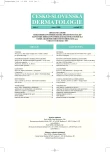Nail Alternariosis – Synergism with Dermatophytes?
Nehtová alternarióza - synergismus s dermatofyty?
Předkládané sdělení informuje o klinickém průběhu a léčbě onemocnění nehtů obou palců na nohou u 57leté ženy. Výsledky mykologických vyšetření, která byla provedena v poslední době, nebyly vždy shodné - při prvním byla ve vzorku nemocné tkáně prokázána Alternaria alternata, druhé vyšetření bylo negativní a při posledním odhalila přímá mikroskopie výskyt septovaných nepigmentovaných vláken v nemocné tkáni a v kultuře rostlo smíšeně Trichophyton rubrum a Alternaria aternata. Dlouhé trvání onemocnění (více než 20 let) a jeho časté recidivy jsou zřejmě projevem dobře etablovaného synergismu obou patogenů. Anamnestické údaje pacientky naznačují, že primární patogen reprezentoval některý z dermatofytů, zatímco plíseň Alternaria alternata infikovala nemocnou tkáň sekundárně. V diskusi jsou shrnuty základní literární údaje týkající se výskytu, klinického průběhu a etiologie onychmykózy.
Klíčová slova:
onychomycosis - nehty na prstech nohy - Alernaria alternata - Trichophyton rubrum -diagnostika - léčba
Authors:
H. Ryšavá
Authors‘ workplace:
Kožní oddělení, Nemocnice Přerov
primář MUDr. Pavel Zíma
Published in:
Čes-slov Derm, 81, 2006, No. 1, p. 20-25
Category:
Case Reports
Overview
Presented paper informs about clinical course and treatment of bilateral toenail disease of a 57-year-old woman. Results of mycological tests, carried out recently, were not always identical – on the first one Alternaria alternata was proved in the infected tissue, the second examination was negative. During the final one the presence of septate non-pigmentate hyphae in the tissue were detected by direct microscopy and Trichophyton rubrum and Alternaria alternata were growing mixed in the culture. Long duration of the disease (more than 20 years) and its frequent relapses are apparently an expression of well established synergism of the both pathogens. History of the patient indicates that the primary pathogen represented some of dermatophytes, while the non-dermatophyte mould Alternaria alternata invaded the infected tissue secondarily. In the discussion basic literature data concerning the occurrence, clinical course and etiology of an onychomycosis are summarized.
Key words:
onychomycosis – toenails – Alternaria alternata – Trichophyton rubrum – diagnostics – treatment
Labels
Dermatology & STDs Paediatric dermatology & STDsArticle was published in
Czech-Slovak Dermatology

2006 Issue 1
Most read in this issue
- Dermatomycological Diagnostics – What Can Be Read out from a KOH Wet Mount?
- Unusual Case of Microsporum canis Infection
- Nail Alternariosis – Synergism with Dermatophytes?
- Epidermal Stem Cell
